 Image search results - "Fukushima" Image search results - "Fukushima" |

Aizu-Wakamatsu Station 会津若松駅
|
|

Marker and side road to Lord Gamo (Gamoh) Ujisato's gravesite. Near Aizu-Wakamatsu City Hall. Gamo Ujisato (1556-1595) was a feudal lord from Hino, Shiga Pref. He built Tsurugajo Castle and named the town Wakamatsu, after a place in his hometown.
|
|

Entrance to Iimoriyama Hill, site of the Byakkotai "White Tiger" Battalion gravesite. In 1868, a unit of teenage warriors called Byakkotai (White Tiger Battalion) fought against the Emperor-backed Imperial forces encroaching their domain of Aizu
|
|

Aizu-Wakamatsu Station 会津若松駅
|
|

Ujisato was married to Oda Nobunaga's second daughter Fuyuhime. He died at age 40. One theory says that he was poisoned by Toyotomi Hideyoshi. Entrance to Lord Gamo Ujisato's gravesite within Kotokuji temple in Aizu-Wakamatsu, Fukushima..
|
|

The Byakkotai were outnumbered and forced to retreat. Twenty of them escaped to Iimoriyama Hill where they saw what looked liked a burning Tsurugajo Castle. Photo: Pay a small fee to take the escalator up the hill. Or climb up the steps for free.
|
|

Aizu-Wakamatsu Station 会津若松駅
|
|

Entrance doors to Lord Gamo Ujisato's gravesite within Kotokuji temple which is a Zen temple of the Rinzai Sect.
|
|

In despair, the boys decided to kill themselves rather than die in the hands of the enemy. Photo: Escalator to go up Iimoriyama Hill.
|
|

Family crest on door. (Not the Gamo crest.)
|
|

Escalator to go up Iimoriyama Hill. Their tombstones are on this hill near where they killed themselves. Their story has become legend.
|
|

Aizu-Wakamatsu Station at twilight
|
|

Grounds of Lord Gamo Ujisato's gravesite within Kotokuji temple. Since Ujisato was a Christian lord, it is ironic that he be buried in a Buddhist temple in Kyoto and Aizu-Wakamatsu.
|
|

Byakkotai Gravesite. It is on a flat area which also has several other Byakkotai monuments including those from other countries.
|
|

Aizu-Wakamatsu Station
|
|
|

Approach to the Byakkotai gravesite.
|
|

Byakkotai statue at Aizu-Wakamatsu Station
|
|

Poem monument reads 限りあれば吹かねど花は散るものを心短き春の山風
|
|
|

Entrance to pedestrian underpass in front of Aizu-Wakamatsu Station
|
|

Path to Lord Gamo Ujisato's gravesite
|
|

Graves of the 19 teenage Byakkotai warriors who killed themselves with their own swords.
|
|

Entrance to pedestrian underpass in front of Aizu-Wakamatsu Station with Byakkotai (White tiger) painting
|
|

Hi-color town bus, very convenient and cheap (500 yen for a day pass) to reach the city's major sights. It runs every 30 min. or so. ハイカラさん
|
|

Lord Gamo Ujisato's grave.
|
|

Byakkotai Graves
|
|

Lord Gamo Ujisato's grave. This is a secondary grave, where his hair is buried. His main grave is at a temple in Kyoto where he died at age 40.
|
|

Hi-color town bus stop
|
|

Byakkotai Graves
|
|
|

Byakkotai gravestones. Each one shows the name, age, and method of death called "jijin" (died with one's own sword 自刃).
|
|

"Akabei" town bus which goes in the opposite direction of the Hi-color town bus. The same day pass can be used for both buses. あかべぇ
|
|

The tombstone has five segments each with a kanji character. 五輪塔
|
|
|

Inside the Akabei town bus.
|
|

Explanation of the kanji characters on the tombstone. From top to bottom, the characters are for "Sky, wind, fire, water, and earth."
|
|

This has become a national shrine, almost as important as Sengakuji where the 47 masterless samurai are buried.
|
|

Bus stop
|
|

Aizu-Wakamatsu City Hall 会津若松市役所
|
|

Portrait of Lord Gamo Ujisato
|
|
|
|

Shopping street
|
|
|
|

Kotokuji temple
|
|
|

Aizu-Wakamatsu manhole
|
|

Fukushima Prefectural Museum
|
|

On the right side are more gravestones. These are 31 Byakkotai members who died in battle. 戦死
|
|

Sculpture near the Fukushima Prefectural Museum
|
|

Tombs of those Byakkotai who died in action.
|
|
|
|

Tombs of those Byakkotai who died in action.
|
|
|

Their names, age, and "senshi" 戦死 (died in battle) are engraved on the stones.
|
|

Hand-painted candles
|
|
|

Monument for teenage samurai who died in battle.
|
|

Names of Byakkotai members, all 14 to 17 years old.
|
|

On the left of the gravestones, there is a monument for a poem composed by Lord Matsudaira Katamori, the last Aizu lord and whom the Byakkotai died for. 幾人の 涙は石にそそぐとも その名は世々に 朽じとぞ思う幾人の 涙は石にそそぐとも その名は世々に 朽じとぞ思う
Ikutari no namida wa ishi ni sosogu tomo sono na wa yoyo ni kuji to zo omou
"No matter how many people pour their tears on these stones, these names will never fade from the world."
|
|

A short walk away is the grave of Iinuma Sadakichi, the only Byakkotai survivor who had slit himself, but was rescued by a villager passing by when everyone else had killed themselves.
|
|

Grave of Iinuma Sadakichi, the only Byakkotai warrior who survived and told the story of this valiant teenage group.
|
|

Grave of Iinuma Sadakichi (Sadao) (1854-1931). His grave was built here in 1957 for the 90th anniversary of the Byakkotai's demise. 飯沼貞吉
|
|

About Iinuma Sadakichi (later changed his first name to Sadao)
|
|

Slope where they committed seppuku (hara-kiri). 自刃の地
|
|

Site where they committed seppuku (hara-kiri). 自刃の地
|
|
|
|
|
|
|
|
|
|

A recent addition is this statue of a teenage samurai looking at Wakamatsu Castle.
|
|

Statue of a teenage samurai looking at Wakamatsu Castle.
|
|
|

Statue faces Tsuruga-jo Castle which can be seen in the distance.
|
|
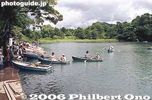
Goshikinuma is a chain of five colorful volcanic ponds. Pleasant hiking trails lead to the ponds. Part of the Bandai-Asahi National Park. Bishamon-numa Pond is the largest of the five and it has rental rowboats. 毘沙門沼
|
|

Arrow points to Tsuruga-jo Castle.
|
|
|
|
|

Colorful koi carp fish in Bishamon-numa Pond, Fukushima Pref. 毘沙門沼Bandai-Asahi National Park
|
|

Byakko Kannon statue
|
|

Bishamon-numa Pond, Fukushima Pref. Bandai-Asahi National Park 毘沙門沼
|
|
|
|
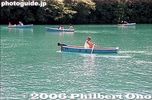
The color of the water is stunningly beautiful.
|
|
|
|

Monument from Rome, Italy, given in 1928 by Mussolini. The column is from the ruins of a palace in Pompeii.
|
|
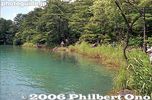
Nature trail to other Goshikinuma ponds.
|
|

Monument message in Italian. After WWII, the US Occupation authorities wanted this monument removed. But all they did was remove the engraved message (later restored).
|
|
|

About the monument from Rome.
|
|
|

Monument from a German, Hasso von Etzdorf (1900 - 1989).
|
|
|

Another monument
|
|
|

Opened in 1956, the Byakkotai Memorial Museum has numerous artifacts related to the Byakkotai as well as the Shinsengumi. Photography inside is not allowed. Admission 400 yen.
|
|

Benten-numa Pond. 弁天沼
|
|

Byakkotai statue outside the Byakkotai Memorial Museum
|
|

Benten-numa Pond, maximum depth 6 meters. 弁天沼Bandai-Asahi National Park
|
|
|
|

Uga Shrine 宇賀神社
|
|

Aonuma Pond 青沼
|
|

Byakkotai enshrined in Uga Shrine
|
|
|

Painting depicting Byakkotai suicide on Iimoriyama Hill
|
|
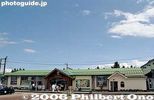
Inawashiro Station 猪苗代駅
|
|

Sazaedo, a unique wooden, hexagonal structure which you will see when coming down from Iimoriyama.
|
|

Sazaedo
|
|

Sazaedo
|
|

Sazaedo
|
|
|

Byakkotai souvenirs
|
|

JR Fukushima Station on the west side (Nishi-guchi).
|
|

Monument on the west side of Fukushima Station. The shinkansen train can be seen.
|
|

JR Fukushima Station on the east side (Higashi-guchi).
|
|

Inside JR Fukushima Station.
|
|

Inside JR Fukushima Station.
|
|

Inside JR Fukushima Station. Sample fireworks balls.
|
|

Toward the west exit the tourist info office on the left. Pick up pamphlets and maps.
|
|

Entrance to the shinkansen tracks.
|
|

JR Fukushima Station shinkansen platform.
|
|

JR Fukushima Station shinkansen platform.
|
|

JR Fukushima Station with shinkansen approaching.
|
|

East exit of JR Fukushima Station has a statue of Haiku poet Matsuo Basho and his traveling companion Sora.
|
|

Around Aug. 7, the Tanabata Matsuri Star Festival is held along Paseo Road, a short walk from the east side of Fukushima Station.
|
|
|
|

Paseo Road Tanabata Matsuri, Fukushima
|
|
|
|
|
|

Poster for Bunka-dori Tanabata Matsuri.
|
|

Paseo Road also intersects with Bunka-dori road which also has its own Tanabata Matsuri with bamboo branches hung with wishes.
|
|

Bunka-dori road Tanabata Matsuri
|
|
|
|

Children's wishes for Tanabata Matsuri on Bunka-dori Road.
|
|
|
|

Fukushima manhole. I think it's waraji straw sandals.
|
|

On the west side of Fukushima Station is a tall building called Corasse Fukushima. The ground floor has the Fukushima Tourism and Product Center selling products of Fukushima.
|
|

Inside the shop, you can find the best products of Fukushima, including edibles.
|
|

Corasse Fukushima also has a lookout deck on the top 12th floor. コラッセふくしま
|
|

Nice views all around.
|
|

View of Fukushima Station's east side.
|
|

View of Fukushima Station's east side.
|
|
|

Clear view of Mt. Shinobuyama 信夫山
|
|

Held on the first Fri. and Sat. of Aug., the Fukushima Waraji Matsuri is mainly an evening parade of dancers. During Aug. 7-8, 2009, the 40th Fukushima Waraji Festival was held. I saw it on the second day.
|
|

"Waraji" means straw sandals. In central Fukushima city, Ashio Shrine (足尾神社) at a mountain called Shinobu-yama (信夫山) has Japan's largest waraji at 12 meters long and weighing 2 tons.
|
|

The giant waraji sandal is an offering for healthy legs/feet. On the first day of the festival (which I missed in 2009), they carry this giant waraji to the festival grounds along Route 13. Here it is displayed at the intersection.
|
|

Closeup of the giant waraji.
|
|
|
|

Ekimae-dori street leading to Fukushima Station is closed to traffic.
|
|

On Aug. 8, 2009 at 12:30 pm, they held the 1st Waraji Day Dance Contest on Ekimae-dori. (わらじDayダンス選手権)
|
|

For a few hours, numerous dance groups performed in a contest. They even had a hula troupe dance, to my delight as I'm from Hawaii.
|
|

Notice anything unusual about these hula dancers?
|
|

Look at their footwear. They are wearing a pair of waraji straw sandals.
|
|
|
|

Many of the dancers wore waraji-related things.
|
|
|

This girl's homemade happi coat says "Waraji Matsuri."
|
|

A panel of judges were there to judge the dancers.
|
|

Each dance group had to perform two numbers. The first one had to be "Dancing Soda Night" for 3 min. and the second one could be anything for 5 min. or less.
|
|

A trio of belly dancers.
|
|

Belly dancer at Fukushima Waraji Matsuri.
|
|

Belly dancer at Fukushima Waraji Matsuri.
|
|
|
|

Belly dancer at Fukushima Waraji Matsuri.
|
|

Announcement of the winners.
|
|

A good-size crowd watched the dance contest.
|
|

Near the intersection of Ekimae-dori and Route 13 was this entertainment stage.
|
|

They also displayed this giant golden waraji.
|
|

Giant golden waraji had ema votive tablets written with people's wishes.
|
|

The giant golden waraji was used to open the waraji races on the second day of the festival.
|
|

On Aug. 8, 2009 from 5:30 pm to 7:30 pm, the second day of the festival, they held waraji races along Route 13 (Shinobu-dori).
|
|

Groups of children, women, etc., were to pull this large waraji on wheels on the 300-meter long race course along Route 13. A pair of large waraji were raced down the road. Then raced back by another pair of racers.
|
|

Waraji race at Fukushima Waraji Matsuri Festival. Each race team had to have 10 members. Also see my YouTube video here.
|
|

After the waraji races, they also had taiko float races where people pulled/pushed a taiko float in a race.
|
|

Finally at 7:30 pm, the main event called Dancing Soda Night started along Route 13 and Ekimae-dori.
|
|
|
|
|
|
|
|

Hula dancers
|
|

Apparently, it was their first time to appear in this festival.
|
|

They weren't wearing waraji.
|
|
|
|
|

School girls
|
|
|
|
|

Many of the dance groups were from dance studios or schools.
|
|
|

Fukushima Waraji Matsuri
|
|

Fukushima Waraji Matsuri
|
|

Eisa group from Okinawa
|
|
|

At the intersection. Notice the giant waraji straw sandal.
|
|

Some fireworks
|
|
|
|

Awards ceremony. The festival ended at about 9:30 pm.
|
|
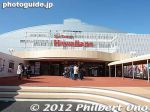
Main entrance to Spa Resort Hawaiians, a huge water park and onsen hot spring amusement facility built in 1966. I visited for the first time shortly after they reopened on Feb. 8, 2012.
|
|
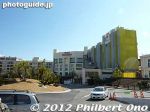
One wing of Hotel Hawaiians was still undergoing repairs to cracks.
|
|

The new Monolith Hotel opened on Feb. 8, 2012.
|
|
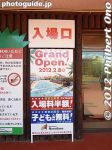
After completing earthquake repairs, the water park re-opened on Feb. 8, 2012. Admission was half price.
|
|

Layout of Spa Resort Hawaiians.
|
|
|
|
|

From JR Yumoto Station, free shuttle buses run to Spa Resort Hawaiians.
|
|

The huge water park at Spa Resort Hawaiians. All the water is from a hot spring. The pool water is lukewarm.
|
|

The whole water park is heated to tropical temperatures even when it is freezing outside.
|
|

The water slides cost extra money. 200 yen per slide.
|
|
|
|
|
|
|
|
|
|
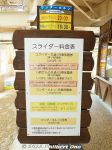
The water slides cost extra money. 200 yen per slide or a day pass for 2,200 yen.
|
|
|
|

Wading pool.
|
|
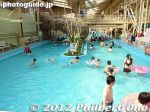
Wading pool.
|
|
|

Besides the pools, there are real hot spring baths where you have to go in naked. Cameras not allowed though.
|
|

Spring Park, a lukewarm hot spring pool.
|
|

Spa Garden Pareo has outdoor pools and a sauna. In winter, the air is freezing cold.
|
|
|
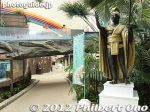
Statue of King Kamehameha even!
|
|

Hula lesson for kids at the Beach Theater in the Water Park.
|
|
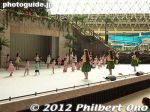
Hula lesson for kids at the Beach Theater in the Water Park.
|
|
|
|
|

Beach Theater shows are free, but they also sell tickets for the best seats for ¥600 to ¥800.
|
|

Colored seats are reserved and cost extra.
|
|

Hula Girl Polynesian Revue at 1:30 pm to 2:15 pm at the Beach Theater.
|
|
|
|
|
|
|
|
| 899 files on 4 page(s) |
1 |
 |
|